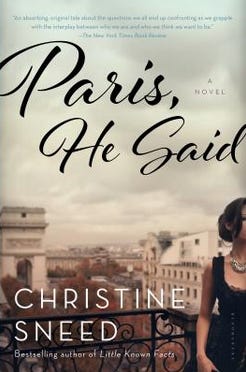What a Character! Incorporating a Living Person into a Work of Fiction
About ten years ago when I started writing the first draft of what became my third book, the novel Paris, He Said, I knew it would focus on a young woman named Jayne Marks who had talent as a painter but didn’t yet have the confidence and discipline required to pursue a career in the arts. Artists interest me as characters in part because for five years after graduate school, I worked at the School of the Art Institute of Chicago in the Student Affairs office.
During those years, I met many painters, sculptors, digital artists, architects, and filmmakers. For two of those years, and for several years afterward, I lived with a visual artist and observed his creative process closely; I also listened to how he spoke about art-making, which, like any profession, has its own lexicon. Hearing him describe for the first time his paintings as more abstract than narrative was a moment I still remember well. As a fiction writer, I realized, I tried for the opposite effect.
When I was well into a complete rewrite of an early draft of Paris, He Said – my editor having gone through the manuscript word by word and asked so many good questions that I knew I couldn’t hope to improve the novel without rewriting about ninety to ninety-five percent of it – I happened to cross paths with a painting instructor I knew from SAIC, Susan Kraut, at a mutual friend’s book release party.
Susan told me she was still teaching at the school and painting in her studio in her Evanston, Illinois home on weekends and on weekdays when she wasn’t on campus. Before long, I heard myself asking if I could include her in Paris, He Said as herself, and would she mind showing me her studio sometime and letting me pester her with questions about her process?
She graciously agreed. She’d read my two previous books and was willing to take a leap of faith that I’d not botch my portrayal of her. I had been floundering for weeks in the tepid waters of the new draft, and Susan’s appearance at our friend Peggy Shinner’s book launch party (for her extremely good essay collection You Feel So Mortal) on that brisk, windy penultimate day of March felt like serendipity.
Two weeks later, I came to Susan’s studio, which is on the top floor of her stately wooden house in central Evanston. She is very modest about her work, despite its moody brilliance, and it wasn’t hard to introduce her into the narrative of Paris, He Said because I knew Jayne needed a mentor, but I wasn’t sure who it would be. Both very talented and effortlessly kind, Susan was perfect for that role.
The biggest challenge was writing truthfully but not sycophantically about her paintings, and about her influence on my character Jayne (in the novel, Susan was one of the few early supporters of Jayne’s paintings). The two women meet at a summer studio class that Jayne enrolled in between her junior and senior years at a college in Washington, D.C. I had to verify that the School of the Art Institute did offer such a class, and it was a lucky break that Susan had taught one of these summer courses many years ago.
Fact-checking was the easy part. What I spent more time thinking and worrying about was how I could make Susan the fictional character compelling in ways that kept the narrative moving forward. I also needed to ensure that her chemistry with the other characters seemed organic. I used her paintings as the point of entry – I described them from Jayne’s point of view (which in this case was also my own) and hoped to establish Susan as someone deserving of readers’ admiration too.
After this, when it was time to show Susan and Jayne together in scene, I thought about our own conversations and email exchanges of the previous several months and tried to imbue them with the gentle supportiveness that seems to come naturally to Susan as a teacher and a friend.
One detail that I ended up pulling out before the book went into galleys was what Susan (the character) tells Jayne before Susan joins her in Paris to take part in a group show: that her husband suspects her of using speed instead of coffee to give herself extra energy. I was concerned readers might think Susan the real person really did use speed. She’s a college professor, a mother of three, etc. If she had been made up wholesale for the book, however, I probably would have retained that detail.
This was the first and only time I’ve included a friend as a character in one of my stories or novels. It was a pleasure because I only had good things to say, but if you can’t portray someone you know personally in a positive fashion, you risk losing this friend (and in a worst-case scenario, being sued for libel). There’s also the chance that what you might really want to write is narrative nonfiction instead of fiction.
The main criterion for including a real person in a story should be whether there is a true dramatic need for this. I didn’t have to shoehorn Susan Kraut into Paris, He Said because Jayne did need a teacher-mentor; Susan’s presence provides context for Jayne’s early and continuing development as an artist. It’s a happy potential corollary to the story that Susan Kraut the artist and living person might also find new admirers.
*A slightly different version of this essay appeared in Glimmer Train’s May 2015 newsletter
Recommendations:
1. Susan Kraut’s paintings are available for sale through the Dan Addington Gallery in Chicago.
2. In a World… - one of the funniest films I’ve ever seen - written, directed, and starring Lake Bell
3. The Tumbleweed - Jenny Shank’s Substack





